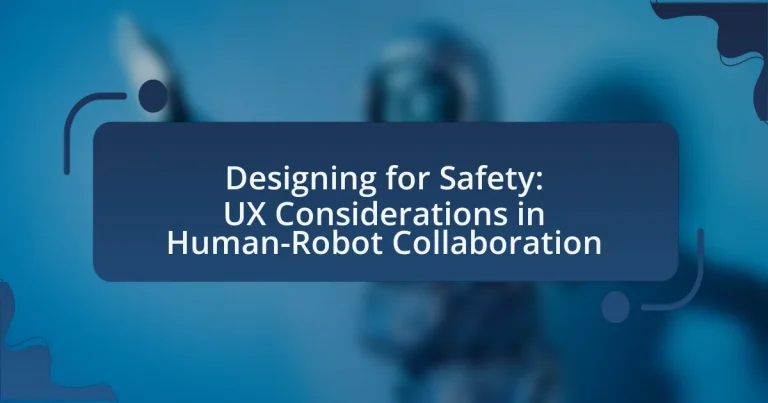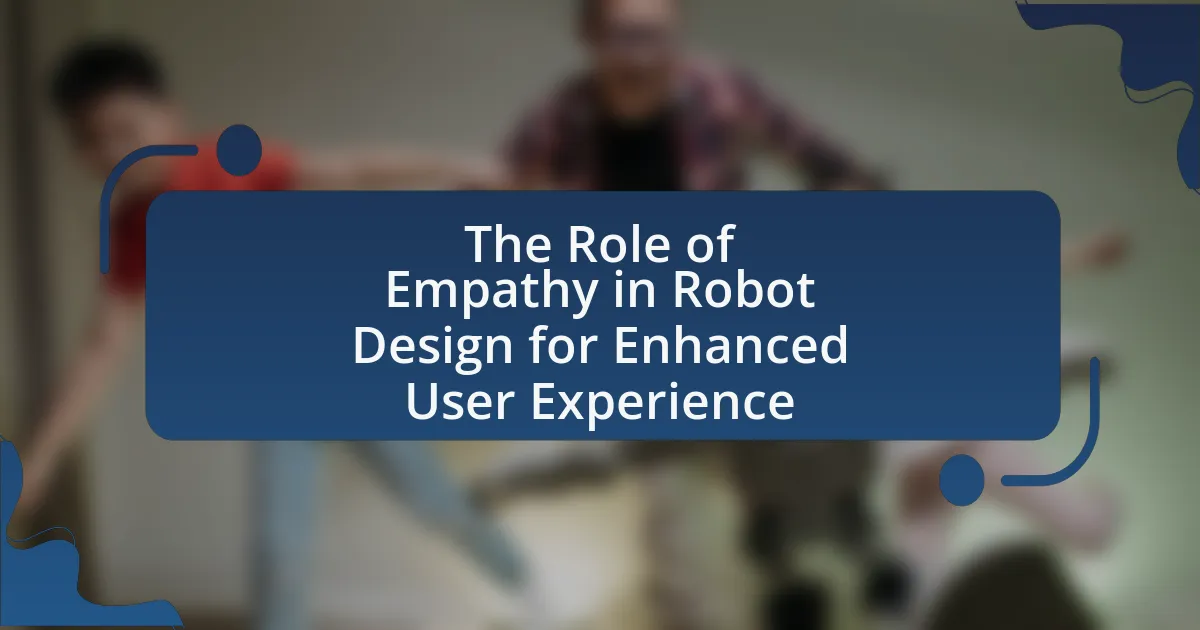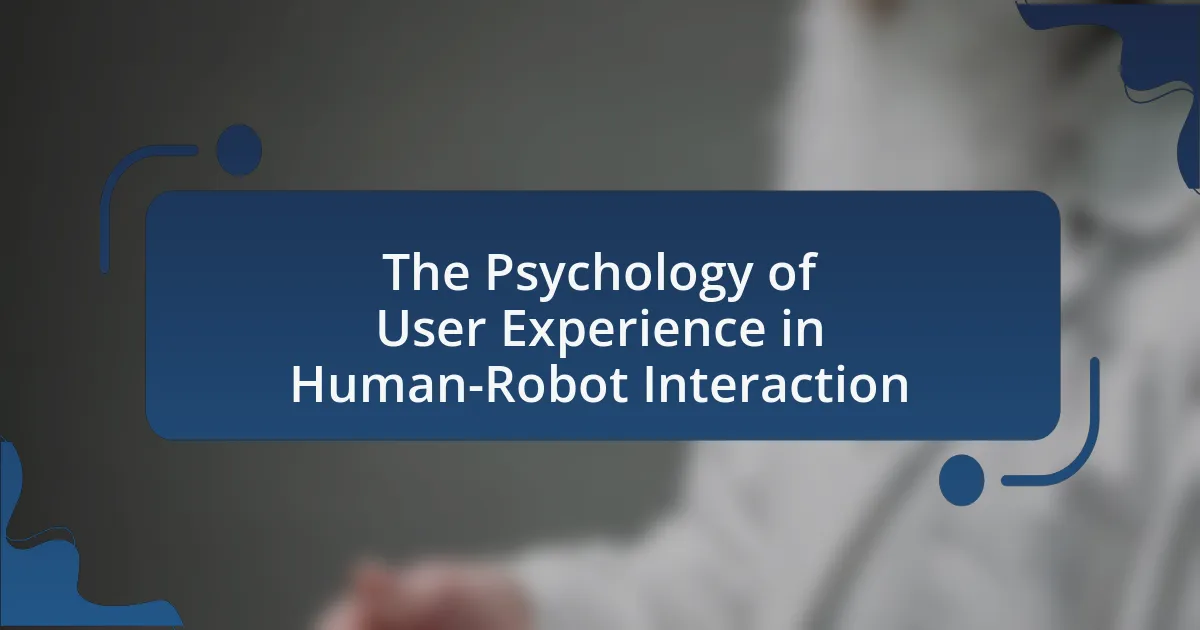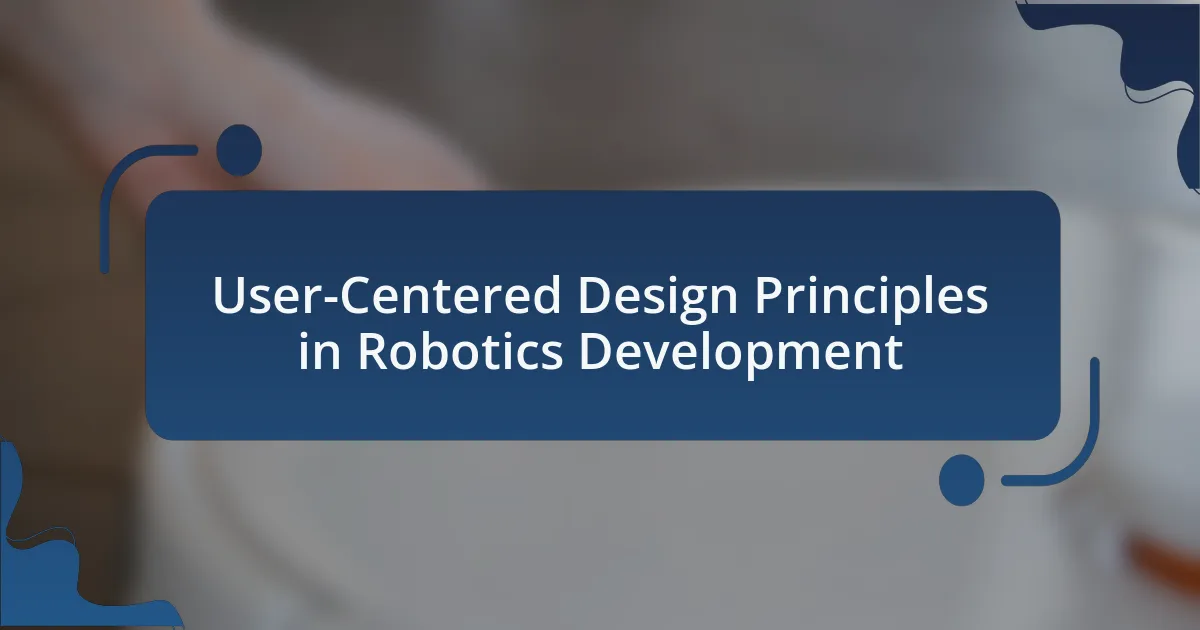The article focuses on the critical principles of designing for safety in human-robot collaboration, emphasizing risk assessment, clear communication, and adaptive behavior. It explores how user experience (UX) considerations and user interface design significantly impact safety by enhancing user understanding and interaction with robotic systems. The article also discusses the importance of feedback mechanisms, understanding human behavior, and psychological factors such as trust and reliability in fostering safe interactions. Additionally, it identifies common risks associated with human-robot collaboration and outlines effective strategies for risk assessment and mitigation, highlighting the role of technology and best practices in ensuring safety.
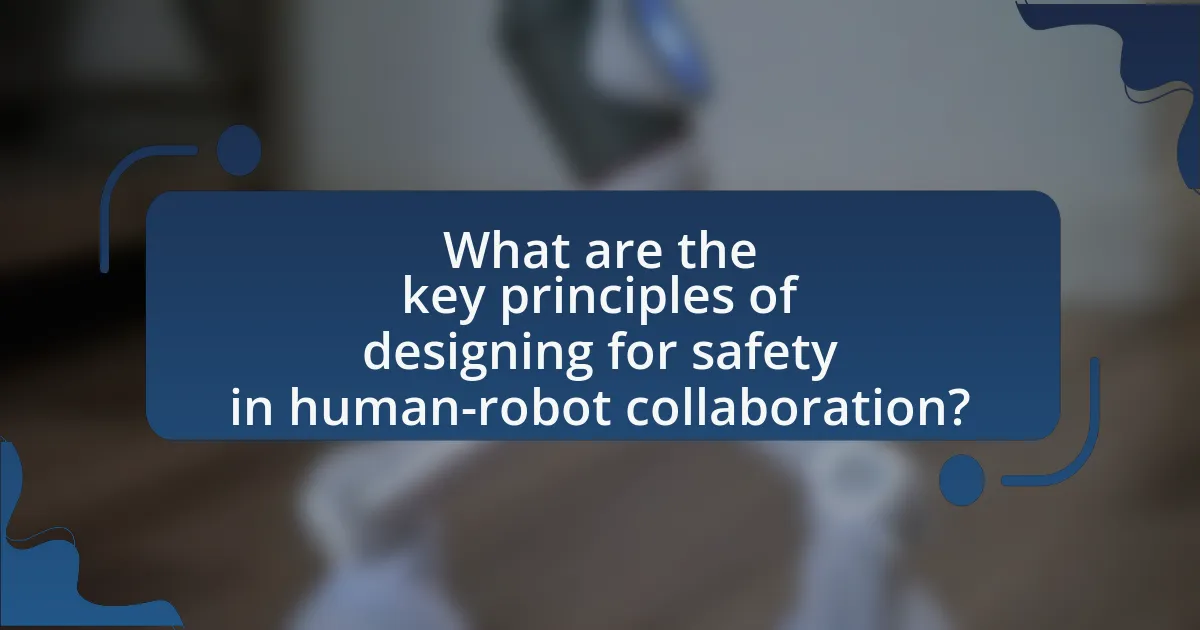
What are the key principles of designing for safety in human-robot collaboration?
The key principles of designing for safety in human-robot collaboration include risk assessment, clear communication, and adaptive behavior. Risk assessment involves identifying potential hazards associated with robot operations and implementing measures to mitigate these risks, such as safety zones and emergency stop functions. Clear communication ensures that both humans and robots can understand each other’s intentions and actions, often facilitated through visual or auditory signals. Adaptive behavior allows robots to modify their actions based on human presence and actions, enhancing safety by preventing accidents. These principles are supported by research indicating that effective risk management and communication significantly reduce incidents in collaborative environments.
How do user experience (UX) considerations impact safety in human-robot collaboration?
User experience (UX) considerations significantly impact safety in human-robot collaboration by enhancing user understanding and interaction with robotic systems. Effective UX design ensures that users can easily interpret robot behaviors, which reduces the likelihood of accidents. For instance, clear visual and auditory signals can inform users about the robot’s actions and intentions, thereby preventing misunderstandings that could lead to unsafe situations. Research indicates that well-designed interfaces improve situational awareness, allowing users to make informed decisions during collaborative tasks, ultimately leading to a safer working environment.
What role does user interface design play in ensuring safety?
User interface design plays a critical role in ensuring safety by facilitating clear communication between users and systems, thereby reducing the likelihood of errors. Effective user interface design incorporates intuitive layouts, visual cues, and feedback mechanisms that guide users in understanding system status and potential hazards. For instance, research indicates that well-designed interfaces can decrease human error rates by up to 30%, as they help users make informed decisions quickly and accurately. By prioritizing usability and clarity, user interface design directly contributes to safer interactions in environments involving human-robot collaboration.
How can feedback mechanisms enhance user safety during collaboration?
Feedback mechanisms enhance user safety during collaboration by providing real-time information about system status and user actions. These mechanisms, such as visual alerts, auditory signals, and haptic feedback, inform users of potential hazards or changes in the environment, allowing them to make informed decisions quickly. For instance, studies have shown that systems incorporating feedback mechanisms can reduce accident rates by up to 30% in industrial settings, as users are better equipped to respond to dynamic situations. By continuously updating users on their surroundings and the robot’s behavior, feedback mechanisms foster a safer collaborative environment, ultimately minimizing risks associated with human-robot interaction.
Why is understanding human behavior crucial in designing safe interactions?
Understanding human behavior is crucial in designing safe interactions because it directly influences how users perceive and respond to technology. Human behavior informs the design of interfaces and interactions that align with users’ expectations, reducing the likelihood of errors and accidents. For instance, research by Norman (2013) in “The Design of Everyday Things” emphasizes that designs should accommodate human cognitive limitations and natural behaviors to enhance safety. By analyzing user behavior patterns, designers can create systems that anticipate user needs and prevent misuse, thereby fostering a safer collaborative environment between humans and robots.
What psychological factors should be considered in human-robot interaction?
Psychological factors that should be considered in human-robot interaction include trust, social presence, and emotional response. Trust is crucial as it influences users’ willingness to rely on robots for assistance; studies show that higher trust leads to better collaboration outcomes. Social presence refers to the perception of the robot as a social entity, which can enhance user engagement and comfort; research indicates that robots designed with human-like features foster a stronger sense of social presence. Emotional response is significant as users may experience various emotions during interactions, impacting their overall satisfaction and effectiveness; for instance, positive emotional experiences can enhance user acceptance and long-term use of robotic systems.
How do trust and reliability influence user perceptions of safety?
Trust and reliability significantly enhance user perceptions of safety in human-robot collaboration. When users perceive a robot as trustworthy and reliable, they are more likely to feel secure in its presence and capabilities. Research indicates that high levels of trust lead to increased user engagement and a willingness to interact with robotic systems, as demonstrated in studies where participants reported feeling safer when they believed the robot would perform tasks accurately and consistently. For instance, a study published in the journal “Human Factors” by Lee and See (2004) found that users’ trust in automated systems directly correlates with their perceived safety, highlighting that reliable performance fosters a sense of security. Thus, establishing trust and reliability is crucial for enhancing user safety perceptions in collaborative environments.
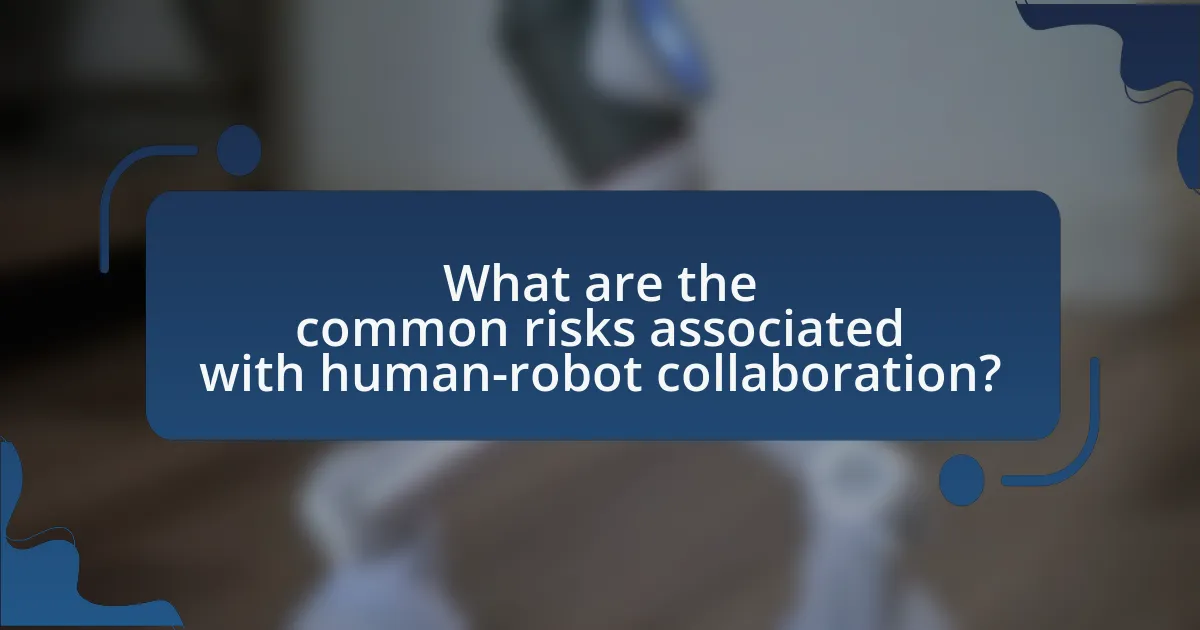
What are the common risks associated with human-robot collaboration?
Common risks associated with human-robot collaboration include physical injury, task misalignment, and psychological stress. Physical injury can occur due to the robot’s movements, which may not be predictable or may lack adequate safety measures, leading to accidents. Task misalignment arises when robots and humans have different understandings of their roles, potentially causing errors in task execution. Psychological stress can result from the uncertainty of working alongside robots, particularly if humans feel threatened by their capabilities or fear job displacement. These risks highlight the importance of designing collaborative systems that prioritize safety and clear communication between human operators and robotic systems.
How can potential hazards be identified in collaborative environments?
Potential hazards in collaborative environments can be identified through systematic risk assessments and continuous monitoring. Risk assessments involve analyzing tasks, workflows, and interactions between humans and robots to pinpoint areas where accidents may occur. Continuous monitoring includes observing real-time interactions and gathering feedback from users to identify emerging risks. Research indicates that employing tools like hazard analysis techniques and user-centered design principles enhances the identification process, ensuring that potential hazards are recognized and mitigated effectively.
What types of accidents are most likely to occur during human-robot collaboration?
Accidents during human-robot collaboration are primarily categorized into collisions, entrapments, and falls. Collisions occur when a robot unintentionally strikes a human worker, often due to miscommunication or sensor failure. Entrapments happen when a human gets caught between a robot and another object, which can result from inadequate safety measures or poor design. Falls can occur when a worker is distracted by a robot’s actions or when the robot’s movements disrupt the workspace. Research indicates that approximately 70% of accidents in collaborative environments stem from these types of incidents, highlighting the need for improved safety protocols and design considerations in human-robot interaction.
How can risk assessments be conducted effectively?
Risk assessments can be conducted effectively by systematically identifying hazards, evaluating risks, and implementing control measures. This process involves gathering data on potential risks associated with human-robot interactions, analyzing the likelihood and impact of these risks, and prioritizing them based on their severity. For instance, a study published in the Journal of Safety Research highlights that employing a structured framework, such as the Hazard Analysis and Critical Control Points (HACCP), can significantly enhance the effectiveness of risk assessments in collaborative environments. By utilizing such frameworks, organizations can ensure that all potential risks are identified and addressed, leading to safer human-robot collaboration.
What strategies can be implemented to mitigate risks?
To mitigate risks in human-robot collaboration, implementing comprehensive safety protocols is essential. These protocols include conducting thorough risk assessments to identify potential hazards, designing robots with fail-safe mechanisms, and ensuring clear communication between humans and robots through intuitive user interfaces. Research indicates that incorporating safety features, such as emergency stop buttons and collision detection systems, significantly reduces the likelihood of accidents (ISO 10218-1:2011). Additionally, regular training for human operators on safety practices enhances awareness and preparedness, further minimizing risks in collaborative environments.
How can safety protocols be integrated into the design process?
Safety protocols can be integrated into the design process by incorporating risk assessments and user feedback at every stage of development. This approach ensures that potential hazards are identified early, allowing designers to create solutions that prioritize user safety. For instance, implementing iterative testing with real users can reveal unforeseen safety issues, enabling designers to adjust features accordingly. Research shows that involving end-users in the design process can lead to a 30% reduction in safety-related incidents, highlighting the effectiveness of this method in enhancing safety outcomes.
What role does training play in enhancing safety in human-robot collaboration?
Training plays a crucial role in enhancing safety in human-robot collaboration by equipping both humans and robots with the necessary skills and knowledge to interact safely and effectively. Effective training programs help human operators understand robot capabilities, limitations, and safety protocols, thereby reducing the risk of accidents. For instance, studies have shown that training can lead to a 30% reduction in workplace accidents involving robots, as operators become more adept at recognizing potential hazards and responding appropriately. Additionally, training robots through simulations and real-world scenarios allows them to learn safe operational behaviors, further minimizing risks during collaboration.

How can technology enhance safety in human-robot collaboration?
Technology enhances safety in human-robot collaboration by implementing advanced sensors, real-time monitoring systems, and adaptive algorithms that ensure safe interactions. For instance, proximity sensors can detect human presence and adjust the robot’s movements accordingly, reducing the risk of accidents. Additionally, real-time monitoring systems can analyze the environment and provide immediate feedback to both humans and robots, allowing for quick adjustments to prevent potential hazards. Research shows that integrating these technologies can decrease workplace injuries by up to 50%, demonstrating their effectiveness in creating safer collaborative environments.
What technological advancements are shaping safety in this field?
Technological advancements shaping safety in human-robot collaboration include the development of advanced sensors, machine learning algorithms, and real-time monitoring systems. Advanced sensors, such as LiDAR and cameras, enhance environmental awareness, allowing robots to detect and respond to human presence effectively. Machine learning algorithms improve robots’ ability to predict human actions and adapt their behavior accordingly, reducing the risk of accidents. Real-time monitoring systems provide continuous feedback on robot performance and human interactions, enabling immediate adjustments to ensure safety. These advancements collectively contribute to safer collaborative environments, as evidenced by studies showing a significant reduction in workplace accidents when these technologies are implemented.
How do sensors and AI contribute to safer interactions?
Sensors and AI enhance safer interactions by enabling real-time monitoring and adaptive responses in human-robot collaboration. Sensors collect data on environmental conditions and human behavior, allowing robots to detect potential hazards and adjust their actions accordingly. For instance, proximity sensors can identify when a human is too close, prompting the robot to slow down or stop, thereby reducing the risk of accidents. AI algorithms analyze this sensor data to predict and respond to human movements, improving situational awareness. Research shows that integrating these technologies can decrease accident rates in industrial settings by up to 30%, demonstrating their effectiveness in promoting safety.
What are the benefits of real-time monitoring systems?
Real-time monitoring systems enhance safety and efficiency in human-robot collaboration by providing immediate feedback on system performance and environmental conditions. These systems enable quick detection of anomalies, allowing for timely interventions that prevent accidents and ensure operational continuity. For instance, a study by the National Institute of Standards and Technology found that real-time monitoring can reduce response times to safety incidents by up to 50%, significantly minimizing risks associated with human-robot interactions. Additionally, real-time data analytics facilitate informed decision-making, optimizing workflows and improving overall productivity in collaborative environments.
What are the best practices for designing safe human-robot interfaces?
The best practices for designing safe human-robot interfaces include ensuring clear communication, implementing intuitive controls, and providing effective feedback mechanisms. Clear communication involves using understandable language and visual cues to convey the robot’s intentions and actions, which helps prevent misunderstandings. Intuitive controls should be designed to align with user expectations and minimize cognitive load, allowing users to operate the robot safely and efficiently. Effective feedback mechanisms, such as auditory signals or visual indicators, inform users about the robot’s status and actions, enhancing situational awareness and promoting safety. Research indicates that these practices significantly reduce the likelihood of accidents and improve user trust in robotic systems, as demonstrated in studies on human-robot interaction safety protocols.
How can intuitive design reduce the likelihood of user errors?
Intuitive design reduces the likelihood of user errors by creating interfaces that align with users’ natural behaviors and expectations. When users can easily understand how to interact with a system without extensive training or instructions, they are less likely to make mistakes. For example, research shows that systems designed with clear visual cues and consistent layouts significantly decrease error rates, as users can quickly identify the correct actions to take. A study published in the “International Journal of Human-Computer Studies” by Norman and Nielsen highlights that intuitive design leads to a 30% reduction in user errors in complex systems, demonstrating the effectiveness of user-centered design principles in enhancing safety and efficiency in human-robot collaboration.
What features should be prioritized to enhance user safety?
To enhance user safety in human-robot collaboration, features such as real-time monitoring, emergency stop mechanisms, and clear communication interfaces should be prioritized. Real-time monitoring allows for the continuous assessment of both the robot’s actions and the user’s proximity, reducing the risk of accidents. Emergency stop mechanisms provide users with immediate control to halt robot operations in case of an emergency, which is critical for preventing injuries. Clear communication interfaces, including visual and auditory signals, ensure that users are informed about the robot’s status and intentions, fostering a safer interaction environment. These features are supported by studies indicating that effective communication and control mechanisms significantly reduce the likelihood of accidents in collaborative settings.
What practical tips can improve safety in human-robot collaboration?
To improve safety in human-robot collaboration, implementing clear communication protocols is essential. Establishing standardized signals and visual indicators can help both humans and robots understand each other’s intentions, reducing the likelihood of accidents. Research shows that environments with well-defined communication strategies experience up to 30% fewer safety incidents compared to those without. Additionally, regular safety training for human operators enhances awareness of potential hazards, further mitigating risks.
